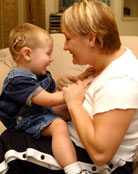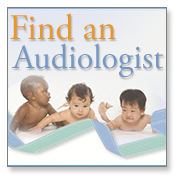Speech Reading
Related Tip

To help your child learn speech reading, you should look directly at your child's face when you are speaking.
Speech reading (or lip reading) is a building block that helps a child with hearing loss understand speech. The child watches the movements of a speaker’s mouth and face, and understands what the speaker is saying. About 40% of the sounds in the English language can be seen on the lips of a speaker in good conditions — such as a well-lit room where the child can see the speaker’s face. But some words can’t be read. For example: “bop”, “mop”, and “pop” look exactly alike when spoken. (You can see this for yourself in a mirror). A good speech reader might be able to see only 4 to 5 words in a 12-word sentence.
Children and adults often use speech reading in combination with other building blocks — such as auditory training (listening), cued speech, and others. But it can’t be successful alone. Babies will naturally begin using this building block if they can see the speaker’s mouth and face. But as a child gets older, he or she will still need some training to use this building block.
Sometimes, when talking with a person who is deaf or hard-of-hearing, people will exaggerate their mouth movements or talk very loudly. Exaggerated mouth movements and a loud voice can make speech reading very hard. It is important to talk in a normal way and look directly at your child’s face and make sure he or she is watching you.
- Page last reviewed: November 17, 2014
- Page last updated: November 17, 2014
- Content source:



 ShareCompartir
ShareCompartir